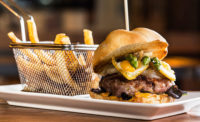 The lunch menu is changing — whether at restaurants, work or schools — due to a recovering economy, high protein prices, increased focus on ethnic cuisine or health. How does the typical chicken or beef item fit into this new atmosphere?
The lunch menu is changing — whether at restaurants, work or schools — due to a recovering economy, high protein prices, increased focus on ethnic cuisine or health. How does the typical chicken or beef item fit into this new atmosphere?
Pretty well, it appears. Chicken is featured in 80.6 percent of lunches; beef in 56.1 percent; shrimp in 44 percent and steak in 34.8 percent, according to Datassential’s MenuTrends US Chains & Independents Database.
“You can see chicken is very big at lunch, but a variety of other proteins including premium options (mortadella, capicola and short ribs) as well as fish/seafood options (nigiri, white tuna, tilapia, haddock and lobster) are growing,” says Maeve Webster, senior director at Datassential, based in Chicago. “While healthy is certainly a part of the changes being made to lunch menus, it’s not the only focus. I think operators are looking at a number of trends from healthy and premium to fresh and ethnic cuisine-inspired.”
According to Technomic’s Top 500 and emerging chain menus, mentions of lunch proteins in entrees has remained relatively stable over the past couple years — based on 10,000 to 12,000 entrees for limited-service restaurants (LSRs) and almost 20,000 for full-service restaurants (FSRs).
“The only movement I saw was slight, but pork increased from being present in 1.8 percent of limited-service [fast-food and fast-casual] entrées in 2012 to 2.1 percent in the first quarter of 2014,” says Deanna Jordan, senior research analyst at Technomic Inc., in Chicago. “On full-service menus, Angus increased slightly from 1.7 percent in 2012 to 2.2 percent in 2014.”
Certainly, operators are trimming their menus, as they grew to the point where kitchens were becoming inefficient, she notes.
“Not to mention, proteins are pricy, particularly when they’re quality options,” says Jordan. “With consumers becoming more aware of what they’re eating, chains have had to step it up and ensure quality. “
Chicken still rules
Chicken is easily the most popular protein on menus, says Jordan, with nearly triple the number of placements on LSR menus compared with other proteins and double on FSR menus.
Next on the list are bacon, ham, beef and turkey (in that order, respectively) on LSR menus, and bacon, shrimp, beef and turkey round out lunch entrees at FSRs, says Jordan.
When eating out, 57 percent of consumers report preferring skinless, boneless chicken breast for lunch, with 45 percent choosing grilled as one of their top three preferred prep methods.
Chicken sandwiches still rule the lunchtime (and dinnertime) menu. For consumers who eat chicken sandwiches, 68 percent say they would be very likely to order this item; 55 percent like warm/toasted deli-style sandwiches; and 52 percent would prefer a wrap, says Jordan.
In the next few years, chicken is only expected to grow in popularity because of its health halo.
“For example, of the 13 percent of consumers who expect to be eating more chicken at restaurants and 25 percent who expect to purchase it more often from retailers, the leading reason (roughly 70 percent of consumers for both restaurants and retailers) is that they are trying to eat healthier and consider chicken to be a more healthful protein than other meat options,” Jordan says, based on consumer data from Technomic’s 2013 “Center of the Plate: Poultry Consumer Trend Report.”
Chicken is also a great avenue for flavor applications, as it lends itself to a variety of cuisines and ethnic influences.
“In fact, 61 percent of consumers would be interested in trying chicken entrées made with new/unique flavors and sauces, and 45 percent strongly agree that restaurants should offer more chicken entrées made with ethnic ingredients and flavors,” says Jordan.
Lighter lunch fare
The lunches themselves being served today are generally viewed by consumers as lighter fare.
“To that end, oftentimes vegetables are the main focus of the meal, with animal proteins being used to garnish or showcase a dish,” says Christopher Hansen, chef, OSI Group LLC, based in Aurora, Ill. “There are many great seasonal ingredients to work with throughout the year, and chefs have access to many fresh items to incorporate in their menu.”
Ethnic dishes employ this approach for many reasons, due to respect for religion, culture, cost, local daily diet, etc., he says.
“They may not even use animal protein; the protein source may be from beans, legumes and soy,” Hansen says. “Animal proteins, however, offer a great source of iron, and are the only natural source of Vitamin B12, so they should continue to play a role in a well-balanced diet.”
Consumers are aware more than ever that protein is an important part of their diets, Hansen says.
“With ethnic foods becoming more popular and continuing to capture market share here in the U.S., we see many versions of chicken, pork, beef and turkey being served across all dayparts,” he says. “Lunch is no exception. Consumers are looking for fun and exciting textures and flavors on traditional cuts of meat.”
In fact, Hansen expects to see more interesting combinations of proteins with new flavors in traditional dishes. “I see the trend for meals offering consumers a good protein source as continuing for some time,” he says.
Brown-bagging it
Are restaurant-goers able to duplicate these meals with bagged lunches? They don’t seem to be trying. Instead, the most popular lunch eaten, regardless of whether it’s eaten at home or carried from home, are sandwiches, says Jennifer Bentz, vice president of insights and innovation at Hillshire Brands Co., based in Chicago.
“And not surprisingly, the majority of those sandwiches contain meat,” she says. “The top in-home sandwich at lunch is ham, while the top carried-from-home sandwich is peanut butter/PBJ, followed by chicken or turkey sandwiches.”
Some highly portable protein items such as yogurt are gaining importance at the carried occasion, as well, Bentz says.
In addition, “frozen meals — of which a majority contains meat — have remained important at the lunch occasion. They are more widely used as a carried lunch compared to an in-home lunch,” she says.
The sluggish economy has motivated some consumers to take bagged lunches to work or eat at home more often.
“Share of food expenditures on food away from home has been trending down for a while,” says Alan Hiebert, senior education coordinator at International Dairy Deli Bakery Association (IDDBA), in Madison, Wis. “I think for a lot of people, taking lunch to work became common during recession years. Some people are still doing it out of habit, some to save money.”
But according to Bentz, carried lunches have declined since 2003.
“Growth in annual eatings at lunch is driven by the in-home occasion,” she says. “Non-meat proteins like peanut butter, yogurt and bars can be found in carried lunches, but don’t look to have replaced other proteins such as lunchmeat and ingredient meat in frozen meals.”
The protein items that are gaining in popularity and being included in bagged lunches more often, she says, are more convenient, flavorful and have healthier consumer perceptions (including higher protein) than their previous versions.
“We are also seeing many consumers increasing protein consumption and including protein-rich foods (like lunchmeat) in their diet,” she says. “When choosing lunchmeat, consumers are increasingly looking for options that may offer lower fat, lower sodium and no nitrites/nitrates options.”
Adding protein
Indeed, parents continue to explore new ways to add protein into their children’s busy lives.
“We’ve seen lunch become a prime parent opportunity to address this,” says Keith Hill, director of brand management at Land O’Frost. “Manufacturers are finding unique and economical ways to fulfill this need,” such as with Land O’Frost’s Simply Delicious line of lunchmeats, certified by the American Heart Association’s Heart-Check Food Certification Program.
Each 50-calorie serving has no byproducts, artificial flavors, hormones or gluten and is extra lean.
“Lunchmeat is a staple of bagged lunches because they offer versatility and convenience at lunchtime to meet family needs,” says Hill. “Healthy food options are also an increasingly popular trend for today’s consumer.”
Pre-packaged lunchmeats are readily available at local grocery stores in a variety of flavors (honey, smoked, oven roasted, etc.), notes Hill, allowing parents to satisfy each child’s pallet.
And while a larger, traditional lunch is still popular, we’re seeing a general trend toward more small meals — snacks, even, says Hiebert.
“Many people do not take an extended lunch break, opting instead to snack at their workstations throughout the day,” he says. “For this reason, convenience becomes quite important to consumers making food choices.”
Healthy lunch, healthy children
For those who remember tacos, burgers, chicken, pizza and mac and cheese as mainstays on lunch menus, the current school lunch would be a total surprise.
The Healthy, Hunger-Free Kids Act of 2010 went into effect for the 2012-13 school year (to good and bad reviews), and is changing how proteins are served at school lunch.
In short, the National School Lunch Program requires students to select either a half cup of fruit or vegetables with their meals, which now have more whole grains, reduced calories and no whole or 2 percent milk.
“Given the strict limits on saturated fat and new limits on calories, all protein choices with school meals must be lean, so you’ll see more choices like turkey hot dogs and turkey sausage than you would in the retail/commercial markets,” says Diane Pratt-Heavner, director of media relations for School Nutrition Association, National Harbor, Md.
A March 2014 Government Accountability Office (GAO) report underscores the challenges of changing a nearly 70-year-old program that reaches 31 million students. Local and state authorities and foodservice directors told GAO researchers that the new standards have caused more waste, higher food costs, challenges with menu planning and difficulties in sourcing products that meet the federal portion and calorie requirements.
Students in particular disliked its previous limit on the number of meats and grains that could be included in a meal, which the USDA has since eliminated, says Pratt-Heavner.
“The USDA has permanently lifted those protein and grain weekly limits, which has given schools a bit more flexibility in their protein portion sizes (although meals still meet calorie limits),” says Pratt-Heavener.
Chicken continues to be a popular protein choice in school cafeterias.
“The School Nutrition Association’s ‘2013 Back to School Trends Survey’ found that 26.7 percent of school districts reported that the most popular lunch entrée was chicken nuggets, tenders, fingers or strips,” says Pratt-Heavener, “and 11 percent of districts reported other types of chicken dishes as the most popular lunch entrée. The new whole-grain standards mean that chicken dishes are breaded in whole-grain-rich breading.”
That said, a variety of protein options are available in cafeterias. “Beef, pork and seafood are all prevalent,” Pratt-Heavener says. Meat alternatives such as cheese pizza and grilled cheese and vegetarian options are also on the menu.
Pork, for one, has become more popular for sausage and ribs sauced and unsauced. “Everything we do in beef, we also do in pork and poultry,” says Brian Hofmeier, vice president of education sales for JTM Food Group in Harrison, Ohio. “But some school districts won’t serve any pork due to religious reasons.”
Beef and pork prices are expected to rise significantly this year, causing school directors to look at turkey and chicken alternatives, notes Hofmeier. “K-12 schools are very reliant on USDA diverted commodities,” he says.
To work with rising prices and nutritional requirements, Hofmeier says his company is blending vegetables such as mushrooms with ground beef for burgers. “So we can deliver a 2.2-ounce patty but with 30 percent less beef than before, and it’s lower in fat but with the same eye appeal and more juiciness,” he says.
Before 2010, he noted every school wanted reduced-fat products, but now everyone wants less sodium. “My company has redone more than 300 products to meet the new requirements,” he says. “The ‘customer’ doesn’t mind eating healthier choices, but doesn’t want health thrown in their face. They don’t eat reduced-fat/low-sodium nuggets; they eat chicken nuggets.”
Hofmeier notes some schools are starting dinner programs (subsidized by the USDA), which are not covered by the new rules.
“Schools work hard to offer a variety of choices,” Pratt-Heavener says. “The trends that we are currently seeing in retail and the commercial market will carry to schools, as well.”
Ethnic, Asian, Hispanic and vegetarian are popular options for students today, Hofmeier says.
“Kids’ most popular places to eat are Chipotle, Subway, Noodles, etc., because they can go down a line and pick exactly what they want,” he says.
Where will consumers buy lunch?
The NPD Group predicted an improving economy will allow for cautious but continuing spending on disposable factors like restaurant lunches. Fast casual restaurants, sub shops and gourmet coffee/doughnut outlets will be the ideal places to accommodate consumers. Convenience stores and food retailers such as Whole Foods Market and Mariano’s Fresh Market should see increased growth, as well.
Beef prices are expected to rise, while chicken prices decrease. So lunch entrees are expected to focus on proteins other than beef, says NPD Group.
The growing Hispanic population will influence proteins to have more flavorful spices and seasonings.
For Asian lunches, protein will have to fit in with noodles, rice and specialty sauces.
Healthy options are still popular, as boomers, seniors, ethnic groups that value fresh prep and younger eaters all value these choices, reported NPD Group.






Report Abusive Comment